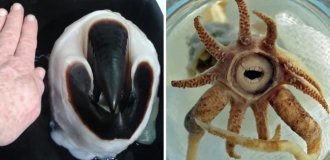The most beautiful Akhal-Teke horses (32 photos + 1 video)
You can rightfully call these handsome purebreds one of the most beautiful horses. Those insanely, bottomlessly beautiful eyes. The appearance is the physique of an expensive sports car among animals. No wonder they compare it to a cheetah. You can admire it for hours and receive aesthetic pleasure.
Let's find out about the origin and roots of these beauties. Also about interesting cases and facts from life. For example, about which Akhal-Teke was worn by the winning marshal G.K. Zhukov at the 1945 victory parade.

The Akhal-Teke horse, or Akhal-Teke, is a riding horse breed bred on the territory of modern Turkmenistan, presumably about 5,000 years ago. This is the oldest of the cultivated breeds, influencing many breeds. It is considered a purebred breed, as it is a standard riding horse and has not been crossed with other breeds for 5,000 years. It is well adapted to dry, hot climates and acclimatizes well in other conditions.


HISTORY OF THE AKHAL-TEKE HORSE BREED
The breed originated from local horses that belonged to the nomads of Central Asia. These horses were known 3500 years ago. Even then, Akhal-Teke horses differed sharply from other horses due to their high stature, lean physique and grace.
By origin, the Akhal-Teke breed is close to the Arabian breed. It is even assumed that these horses may be the ancestors of Arabian horses, but most likely these breeds developed in parallel.
In ancient times, Akhal-Teke horses were bred in the Parthian kingdom, and later they began to be bred in Turkmenistan and Persia. And only the Turkmens managed to preserve the breed in the country. This was facilitated by the fact that horses were highly valued by the Turkmens, since they were the only means of transportation; the lives of riders during wars depended on horses. Horses were grazed in oases, fed with grain and cakes, and in winter they were brought into tents and covered with blankets. The best horses were kept not in a herd, but near the home, and the owner devoted a lot of time to training, as a result of which the horses bit and kicked the opponent’s horse in battle, helping the owner gain the upper hand.

Thanks to this maintenance of Akhal-Teke horses, they developed a special character and external characteristics. Over the centuries, the external characteristics of Akhal-Teke horses have not changed; today they look the same as in ancient times.
Since ancient times, horses have been a “bargaining chip” in political games. Sometimes they even decided destinies. For example, the Emperor of Persia Cyrus married the daughter of the king of Media only in order to get the horses of Bactria. And the famous commander Alexander the Great, having become the legal husband of the daughter of the Baltic king, Roxana, received the bravest and fastest horses of that time. It was thanks to these horses that he achieved his most brilliant victories. The Emperor of the Roman Empire, Probu, received as a gift an Akhal-Teke horse, which could cover a distance of 150 km per day for 10 days.

In the 9th–10th centuries AD. Akhal-Teke horses were at a high price in the Baghdad Caliphate. Genghis Khan, the Persian king Darius the Great and many other famous commanders used Akhal-Teke horses in their campaigns.
The famous traveler Marco Polo paid tribute to the Akhal-Teke horses. In his notes, he noted that magnificent horses are bred in Turkmenistan, which are then sold for 200 livres. Marco will trace the origins of the Akhal-Teke back to Bucephalus, the famous horse of Alexander the Great.

After it became possible to travel from Europe to India by sea, the importance of the Silk Road passing through Turkmenistan decreased. The peoples who lived on the territory of this route were “forgotten.” And, starting from the 17th century, the role of the Akhal-Teke horse was mistakenly attributed to the Arabian.

Turkmens idolized horses. They surrounded the foals with care from the first days of life, raising them like family members. Harsh environmental conditions contributed to the fact that the Akhal-Teke horses developed an adaptability to work in hot weather and a unique physique. Representatives of this breed became dry and lean, without excess fat.

In Russia, Akhal-Teke horses were known as Argamaks - a common name for all eastern breeds of horses. Many Russian breeds contain Akhal-Teke blood - especially the Russian Saddlebred and Don breeds. The famous Russian hippologist, V.O. Witt, argued that the Akhal-Teke breed is the golden fund of the riding horse of the whole world, the last drops of the source that created the entire world horse breeding.

The Turkmens were very fond of horse racing and took a very responsible approach to preparing horses. Invaluable experience was passed on from generation to generation. The training system developed by the Turkmen had much in common with the system of preparing thoroughbred stallions for racing in Europe. Akhal-Teke horses are among the fastest in the world. The physique and structure of these horses make them natural racers.


GENERAL CHARACTERISTICS OF AKHAL-TEKE HORSES
Color: red, black and bay, often with a beautiful golden sheen. There are also gray, dun, isabella, salt, and karak.
Use: universal riding horses. Used in many equestrian disciplines. Thanks to their endurance, they can take part in tiring runs. Often used in dressage.
Features: energetic, obedient, agile. They are famous for their endurance. They tolerate heat without problems and drink little water. They stand out for their graceful forms and beautiful, graceful movements.
The Akhal-Teke horse is a real work of art, the well-deserved pride of breeders, the result of the work of many generations of horse breeders. Anyone who has seen an Akhal-Teke dog at least once will never again confuse it with a representative of another breed.

The Akhal-Teke horse has an unusual exterior. The appearance of this breed radically distinguishes it from other horse breeds.
Akhal-Teke horses have a fairly large stature (on average about 160 cm at the withers for stallions) and an extremely dry constitution. Akhal-Teke horses are compared in shape to greyhounds or cheetahs. The entire appearance is dominated by long lines. Other measurements of stallions: oblique body length - 160-165 cm, chest girth - 175-190 cm, pastern girth - 19-20 cm.

The chest is deep, oval in shape, with long false ribs. The withers are high and long, well muscled. The back and loin are long. The croup is slightly sloping, wide and long, with well-developed muscles, the tail is set low. The legs are long and thin, with well-developed joints and small, strong hooves.

The shapes of the head and neck are very unique. The head has a straight or hook-nosed profile, sometimes with a slightly convex forehead, its facial part is thin and elongated. The ears are long, thin, and fairly widely spaced.
The eyes are large, expressive, but have an unusual elongated, slightly slanting shape (“Asian eye”). The neck is high set, thin, long, straight or S-shaped (the so-called “deer” neck is often observed) with a long nape.

The skin is thin, and a network of blood vessels easily appears through it. The hair is extremely thin, delicate and silky; the mane is sparse and sparse, and most often it is completely cut off, which distinguishes the Akhal-Teke horse from other breeds of horses. Temperament is ardent.
The colors are varied, in addition to the main and most common ones - bay, black, red and gray - there are rare dun, nightingale, isabella, karak, brown. White markings on the legs and face may be present. All colors are characterized by a bright golden or silvery sheen to the coat.


CHARACTERISTIC FEATURES OF THE BREED
The walk, trot and canter of this breed are smooth and high. This method of movement was developed by Akhal-Teke horses when moving through the shifting sands of deserts. Although these horses look very elegant in appearance, they are distinguished by increased endurance: they can go for long periods of time without water and food, make long journeys, tolerate hot climates well, they are not very well adapted to frosts, but tolerate them better than other southern breeds.
This breed is a riding breed, therefore it is adapted to walking under saddle. The character was formed as a result of special conditions of detention. Since horses were often kept alone, in close proximity to housing, Akhal-Teke horses developed a high attachment to people. They are called one-owner horses because they have a hard time surviving a change of owner.

They require a subtle psychological approach. Akhal-Teke horses are very smart, they sense the rider very well, but at the same time they are independent, and if the rider fails to establish contact with the horse, the horse will decide for itself what to do. That is why Akhal-Teke horses are considered difficult for sport. But they are very loyal. Like all southern breeds, they have a “hot” disposition; they get excited quickly, but do not show excessive aggression.

The modern name was given to the breed from the place where these horses were preserved in purity in the Ahal oasis, stretching along the northern foot of the Kopet Dag from Bakharden to Artyk, which was inhabited by the Turkmen tribe Teke (or Tekins). Thus, literally “Ahal-Teke” is a horse of the Teke tribe from the Ahal oasis.

The breed became known under this name in the Russian Empire after the annexation of Turkmenistan and especially during the Soviet years. Similarly, the name of this breed, with which Europeans reacquainted themselves in the 20th century, sounds in other languages, for example: English. Akhal-Teke, fr. Akhal-Teke, Netherlands Akhal-Teke, German. Achal Tekkiner, Swedish Achaltekeer, etc.

The breed was influenced by the way of life that was inherent to the Turkmens. Features of feeding, traditional training and use - a combination of fast racing over short distances and long, grueling hikes - all this affected the exterior and interior (internal features) of the breed: the horses became lean and dry, without excess fat, unusually hardy and not demanding in terms of quantity ( and to the quality) of food.

The Akhal-Teke horse is very good for riding; its movements are elastic and not tiring for the rider. At the same time, rudeness or neglect hurts the Akhal-Teke much more than many other horses. Like all purebred horses, the Akhal-Teke breed does not in any way correspond to the role of a “sports equipment” that fulfills any requirements of the rider; it requires a special approach. Therefore, many athletes, accustomed to more phlegmatic and trouble-free half-bred horses, consider Akhal-Teke horses to be difficult to work with. But in the hands of an intelligent and patient rider, an Akhal-Teke horse is capable of showing high athletic results.

Being descendants of wild and domesticated horses, which were raised in harsh desert conditions and lived in the sands of the Karakum Desert, Akhal-Teke horses could not help but inherit incredible endurance and adaptability to environmental conditions from their ancestors. It is precisely the conditions of viscous sand that the Akhal-Teke owe their unusual gaits: while moving at a walk and trot, it seems that the horse is smoothly floating above the ground without touching it with its feet. This method of movement helped the Akhal-Teke horses to walk easily even on quicksand.

Despite its thin, delicate skin and very short hair, the Akhal-Teke horse can tolerate temperatures over a wide range - from -30 to + 50 °C, as well as serious temperature changes.
The external fragility of the breed hides incredible endurance. As historians say, there were cases when an Akhal-Teke wounded in battle by a saber blow carried away two adult men on his back, leaving with them through quicksand. In modern history, horses of the Akhal-Teke breed have repeatedly made record-breaking multi-day hikes and sports runs. The most famous Akhal-Teke race took place in 1935 along the Ashgabat-Moscow route. This distance was covered in 84 days, and the riders covered the sands of the Karakum Desert in three days without stopping for food, drink or sleep. All horses remained healthy and reached Moscow. The winner of that race was the dun stallion Tarlan.

The breed cultivates lines that go back mainly to the famous 19th-century horse Boinou: the stallions Melekush (Boinou - Oraz Niyaz Karadyshli 1909; in 1956, was presented by N. S. Khrushchev as a gift to Elizabeth II), Everdy Teleke and Sapar Khan. Other main genealogical lines in the modern Akhal-Teke breed are the lines of Gelishikli (Fakir Sulu - Gezel 1949), Arab, Kaplan, Kir Sakara (Algyr - Aiden 1936), Elya (Tugurbai - Elkab 1932) and Fakirpelvan (Fakir Sulu - Egoza 1951).

Akhal-Teke horses today are shown at races, as well as show rings at Russian and world championships, as well as in the rings of major events dedicated to horses, for example, the Equiros International Horse Show in Moscow. The World Cup show championship, established by the stud farm named after Vladimir Shamborant, is held annually at Equiros. The World Cup is the largest show event of the Akhal-Teke breed. The breed is cultivated in many countries around the world.

The Akhal-Teke horse is represented on the Turkmen state emblem, banknotes of Turkmenistan and the Republic of Belarus, as well as on postage stamps of both Turkmenistan itself and other countries.
For a long time it was believed that G. K. Zhukov hosted the first Victory Parade in 1945 on the famous Akhal-Teke Arab, a descendant of Boynow. The image of Marshal Zhukov on horseback is depicted in cinema, painting, sculpture, coins and postage stamps. In the 1980s, a new version about Zhukov’s horse arose: he was a stallion named Kumir, born at the Terek stud farm. In the magazine “Horse World” for 2005, this version was questioned, since all horses of the Terek breed have a characteristic brand.

In 2006, information about the Terek stallion Idol was confirmed. However, in 2010, in connection with the military parade in Moscow in honor of the 65th anniversary of Victory in the Great Patriotic War, the original version about Marshal Zhukov’s horse was again disseminated in some media.
The 2010 parade featured the Akhal-Teke horse Gyrat, a direct descendant of the Arab, which was allegedly used in the first parade in 1945. According to other reports, historians and participants in the legendary 1945 event have discovered significant differences in the breeds of horses participating in the two parades.

Having passed through millennia, the Akhal-Teke horse breed has remained unchanged thanks to traditional methods of folk selection. In the absence of a stud book, the pedigrees of horses were kept in the memory of the Turkmens and passed on from mouth to mouth, but in the 20th century the breed began to decline.
Serious damage was caused to her by... factory breeding, or rather an attempt to bureaucratically manage this process. Thus, in the 70-80s of the twentieth century, all Turkmen stud farms involved in breeding Akhal-Teke horses received a directive to reduce the number of livestock. Its blind implementation led to the fact that the best breeding horses were simply sent to slaughter for no apparent reason. By the way, the Turkmens themselves refused to eat sausage made from the meat of Akhal-Teke horses, because these horses were rightfully considered the national treasure of the Turkmens.

As a result, the population of the Akhal-Teke breed not only decreased, but also lost its genetic diversity. And only when the status of the breed became threatening, they began to breed it again. Now the largest population of these horses is in their historical homeland - in Turkmenistan; Russia has become the second largest breeding center.

Also, a small number of Akhal-Teke horses are found in various European countries and the USA, where this breed is highly valued and loved for its extraordinary beauty and uniqueness. Indeed, there is no similar breed in the world with the same beautiful movements, iridescent coat and proudly swan-like set of neck. At European auctions, Akhal-Teke horses are on a par with high-quality Arabian horses. Despite their relative rarity and high cost, Akhal-Teke horses are extremely popular among horse connoisseurs and are kept in elite stables.






















